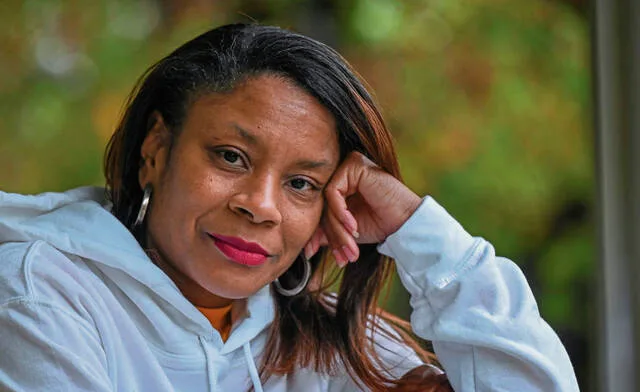
Jenea Edwards sometimes feels a twinge of sadness when she sees a little girl.
There was a time when Edwards looked forward to matching mother-daughter outfits and making visits to the nail salon together. Now it’s a reminder of what could have been.
With one big kick on the way to a routine checkup, those hopes and dreams borne over a six-month pregnancy were gone in an instant. Edwards said she thinks that kick was her daughter’s way of saying goodbye.
Hours later, after learning the baby growing in her womb no longer had a heartbeat, she met the daughter she named Madison — Maddie for short — but didn’t take home.
“I just couldn’t get myself to cry, and it wasn’t that I wasn’t sad — because I was,” Edwards said. “I was just trying to process everything because everything went so fast.”
The issue is at the forefront of a wide-ranging collaboration in Allegheny County that seeks to reduce the Black infant mortality rate — the number of deaths of children younger than 1 per 1,000 births — and help all babies born in the Greater Pittsburgh region mark their first birthday.
Black infant mortality is an urgent problem, said Dr. Margaret Larkins-Pettigrew, senior vice president and chief clinical diversity, equity and inclusion officer at Allegheny Health Network. The health system is collaborating with UPMC, community-based organizations, birth workers, nonprofits and others through First Steps and Beyond, a program launched in early 2022 to address the disparity.
So far, the unified strategy is showing promise.
“We have the best medical care that can be offered, and this should not be happening anywhere,” Larkins-Pettigrew said.
A 2019 report by the City of Pittsburgh’s Gender Equity Commission, with help from University of Pittsburgh researchers, found that babies born to a Black parent were twice as likely to die than those born to a white parent — 18 deaths compared with nine, per 1,000 births.
Those Black infants are more likely to have a lower birth weight and an abnormal condition or congenital anomaly than their white counterparts — 14% are born under 5½ pounds, the study found. It’s an issue that affects Black parents regardless of income and education levels, researchers said.
About 14% of births by Black parents were preterm compared with 9% by white parents, according to the Allegheny County 2019 Natality Report. There were 12,816 live births to Allegheny County parents in 2018, about 20% of which involved Black parents.
Similar statistics are not available for Westmoreland County, because it does not have its own health department. Because 3% of the population in Westmoreland County is Black, births there are not as diverse as in Allegheny, where the population is 13.5%.
Education efforts
Nationally, the Black infant mortality rate is 10.6 deaths per 1,000, more than twice the rate for white babies, according to the Centers for Disease Control and Prevention. The figures are about the same for Pennsylvania.
Partners in the multifaceted Allegheny County effort have been working to learn more about the lives of pregnant Black women, how Black people interact with health care providers and their community, and what happens after the baby arrives. Those findings can help direct resources where they are needed, such as in sleep education to reduce sudden infant deaths.
“Increasing support in the fourth trimester is critical,” Larkins-Pettigrew said.
A committee looking at the reasons for fetal and infant deaths and what can be done to prevent them was established more than a year ago, said Demia Tyler, director of strategic initiatives with Healthy Start Pittsburgh, which was launched in 1991 by the federal government.
Some of those factors can stem from racism a Black person experiences throughout their lives and at medical appointments during pregnancy, Tyler and Larkins-Pettigrew said. Their immune systems might be compromised because of that experience or they might have an existing medical condition. They might be met with barriers or inequities involved in access to health care or situations where symptoms are brushed off by medical professionals.
All of those factors can have an impact on birth outcomes, Tyler said.
“They’re going into the hospital and not treated respectfully,” she said, adding that Black parents who are educated and have a high income are not immune.
A similar program — First Year Cleveland — was established in 2015. In 2018, the Black infant mortality rate in Cleveland was 17.5 per 1,000, nearly six times that of white babies, according to the initiative. Last year, city statistics showed the disparity reduced to about double, with Black infant mortality around 14.4 per 1,000.
Gathering data
UPMC researchers have been working to better understand causes and issues that lead to infant mortality by gathering data from people who are pregnant and in the first year after delivery, said Dr. Yoel Sadovsky, lead investigator and executive director of Magee-Womens Research Institute.
They are learning about how relationships, stress and other factors correlate with health record information in an effort to help inform doctors and patients about potential risk factors.
Sadovsky said he hopes those findings will be available to doctors everywhere and improve infant mortality rates, which he described as a major indicator of well-being in a society.
“This has been an issue not only in Allegheny County and Western Pennsylvania — this is a broader issue that affects people across the world,” he said.
Tyler agreed, adding that reducing challenges for Black babies means improving outcomes for all children.
“The health and vitality of our babies is really the greatest indicator of the health and vitality of our community as a whole,” she said.
Infant mortality rates in general are typically better in urban counties than in rural ones, according to the Centers for Disease Control and Prevention. Rural hospitals across the country have been closing their labor and delivery units, creating so-called “maternity care deserts,” counties with no hospitals or birth centers and no OB providers, the Associated Press reported.
Residents in Allegheny and Westmoreland counties have full access to maternity care, according to a March of Dimes report. Greene County is considered a maternity care desert, and Fayette has low access.
‘It’s your new reality’
Edwards didn’t know about the racial disparity when she was pregnant with her son, Elijah, or with Maddie. Elijah was 1 when Edwards was pregnant with Maddie.
But Edwards knows the pain of losing a child.
“I’m going home without my baby,” she remembered thinking in the hospital. “How do you face the world without your baby?”
Today, Edwards is committed to helping others who have experienced the same loss through a support group named for her daughter — Maddie’s GEMs. The group holds a march and balloon release every October, which is Pregnancy and Infant Loss Awareness Month.
“People really don’t know what to say … because it’s not a normal thing to lose your baby,” Edwards said. “This is something you can’t get over. It’s your new reality.”
Edwards gathered with family, friends and others who have experienced such a loss on a rainy day this month at Riverview Park in Pittsburgh. They released pink and blue star-shaped balloons in memory of their lost babies.
Takiyah Durham, director of First Steps and Beyond, said people such as Edwards are important pieces of the initiative and can help to guide policy decisions while connecting with community members.
“They have lived (the) experience, so their voice matters,” Durham said.
Andrea James of Penn Hills has that experience, too. She gets a big smile when she says her son’s name: Tyler.
In January 2009, she learned that the crib and first suit she had waiting for him weren’t needed because his heart had stopped beating while in her womb. She was 30 weeks pregnant. The memories still bring tears to her eyes.
A couple of women in her life were pregnant around the same time, and James always wants to know about those now-teenagers’ lives.
“I keep track of those babies,” she said, adding she often wonders what Tyler would’ve been doing — what sports he would be playing or who his friends would be.
Edwards and her family celebrate Maddie’s birthday on May 24. She would’ve turned 10 this year and surely would’ve had the typical brother-sister relationship with Elijah, now 11.
She doesn’t know what life would be like if Maddie were part of it. But the experience of losing her daughter brought her an added purpose.
“If I can prevent someone else from going through it,” she said, “then that’s my goal.”
Renatta Signorini is a Tribune-Review staff writer. You can contact Renatta by email at rsignorini@triblive.com or via Twitter .


